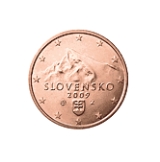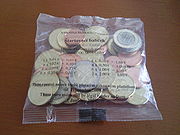
Slovak euro coins
Encyclopedia

Slovakia
The Slovak Republic is a landlocked state in Central Europe. It has a population of over five million and an area of about . Slovakia is bordered by the Czech Republic and Austria to the west, Poland to the north, Ukraine to the east and Hungary to the south...
has been a member of the European Union
European Union
The European Union is an economic and political union of 27 independent member states which are located primarily in Europe. The EU traces its origins from the European Coal and Steel Community and the European Economic Community , formed by six countries in 1958...
since May 2004, and is a member of the European Economic and Monetary Union
Economic and Monetary Union of the European Union
The Economic and Monetary Union is an umbrella term for the group of policies aimed at converging the economies of members of the European Union in three stages so as to allow them to adopt a single currency, the euro. As such, it is largely synonymous with the eurozone.All member states of the...
. Slovakia adopted the euro
Euro
The euro is the official currency of the eurozone: 17 of the 27 member states of the European Union. It is also the currency used by the Institutions of the European Union. The eurozone consists of Austria, Belgium, Cyprus, Estonia, Finland, France, Germany, Greece, Ireland, Italy, Luxembourg,...
on 1 January 2009, replacing its previous currency, the Slovak koruna
Slovak koruna
In 1993, coins were introduced in denominations of 10, 20 and 50 haliers, 1, 2, 5 and 10 korunas. The 10 and 20 halier coins were taken out of circulation on 31 December 2003....
.
Adopting the euro
In 2005, an official public contest for Slovak euro coin designs was held, which took place over two rounds. The deadline for the first round was 31 January 2005, after which the ten top designers chosen by the National Bank of SlovakiaNational Bank of Slovakia
National Bank of Slovakia , is the central bank of Slovakia, which is a member of the European Union and the European System of Central Banks. Since 1 January 2009, it has also been a member of Eurosystem.-History:...
(NBS) were invited to make plaster
Plaster
Plaster is a building material used for coating walls and ceilings. Plaster starts as a dry powder similar to mortar or cement and like those materials it is mixed with water to form a paste which liberates heat and then hardens. Unlike mortar and cement, plaster remains quite soft after setting,...
reliefs of their designs. In the second round, the NBS called a public vote conducted from 12 November until 20 November 2005 on the ten designs that were picked from the over 200 submissions. On 21 November 2005, the results were made public; the most popular design was the Coat of arms of Slovakia
Coat of arms of Slovakia
The coat of arms of Slovakia consists of a red shield, in early gothic style, charged with a silver double cross standing on the middle peak of a dark blue mountain consisting of three peaks. Extremities of the cross are amplificated, and its ends are concaved...
. On 20 December 2005, the design for the Slovak euro coins was officially made public on the NBS website. Since then Slovakia has been doing economic reforms to be able to adopt the euro.
After three years of reforms, on 1 April 2008, the NBS announced their plan for withdrawal, disposal and destruction of the Slovak koruna
Slovak koruna
In 1993, coins were introduced in denominations of 10, 20 and 50 haliers, 1, 2, 5 and 10 korunas. The 10 and 20 halier coins were taken out of circulation on 31 December 2003....
notes and coins. On 7 May 2008, the European Commission
European Commission
The European Commission is the executive body of the European Union. The body is responsible for proposing legislation, implementing decisions, upholding the Union's treaties and the general day-to-day running of the Union....
approved the application and asked member states to endorse the bid during the EU finance minister's meeting in July 2008. Slovakia's 12 month inflation was 2.2% compared with 3.2% that is required. Annual inflation however was 3.6% for March 2008. Fiscal deficit was 2.2% versus the reference value of 3.0%. And finally the government debt ratio was 29.4% of GDP in 2007, well below the maximum ratio of 60.0%.
On 3 June 2008 European Union finance ministers gave Slovakia the green light to join the euro zone in 2009 while urging the country to be ready to fight inflation with tight fiscal policies. "We are happy to see Slovakia join the euro zone on January 1, 2009," Jean-Claude Juncker
Jean-Claude Juncker
Jean-Claude Juncker is a Luxembourg politician, 23rd and current Prime Minister of Luxembourg, since 20 January 1995. He is the longest standing head of government of any European Union state...
, who chairs the Eurogroup of euro zone
Eurozone
The eurozone , officially called the euro area, is an economic and monetary union of seventeen European Union member states that have adopted the euro as their common currency and sole legal tender...
finance ministers, told reporters.
Slovakia's mint has been tasked to produce some 500 million euro and cent coins. As a preparation for the change on January 1, starting from November 2008, these coins will be distributed to businesses all over Slovakia.
On 17 June 2008, the European Parliament agreed to Slovakia's bid to join the euro zone from the start of 2009, urging the country to tighten fiscal policies to avoid inflationary risks. The assembly voted 589 to 17 with 86 abstentions to approve a report that said the European Union newcomer met all euro entry criteria. However, the parliament's role is consultative only. Slovakia's bid to become the euro zone's 16th member was approved by EU leaders. EU finance ministers set the final conversion rate
Conversion rate
In internet marketing, conversion rate is the ratio of visitors who convert casual content views or website visits into desired actions based on subtle or direct requests from marketers, advertisers, and content creators...
of the Slovak koruna into the euro on 8 July 2008.
On 19 June 2008, the leaders of the EU Member States confirmed Slovakia's readiness to join the eurozone on 1 January 2009. “I congratulate Slovakia for meeting all the relevant criteria,” said the current President of the European Council
Presidency of the Council of the European Union
The Presidency of the Council of the European Union is the responsibility for the functioning of the Council of the European Union that rotates between the member states of the European Union every six months. The presidency is not a single president but rather the task is undertaken by a national...
and Slovenia
Slovenia
Slovenia , officially the Republic of Slovenia , is a country in Central and Southeastern Europe touching the Alps and bordering the Mediterranean. Slovenia borders Italy to the west, Croatia to the south and east, Hungary to the northeast, and Austria to the north, and also has a small portion of...
n Prime Minister Janez Janša
Janez Janša
Janez Janša is a Slovenian politician who was Prime Minister of Slovenia from November 2004 to November 2008. He has also been President of the Slovenian Democratic Party since 1993...
.
On 8 July 2008, The European Union formally invited Slovakia to join the European single currency and set the official rate at which korunas will be exchanged for euros - 30.1260 korunas to the euro.
On 5 September 2008, as part of the preparations for euro adoption, the NBS announced that by the end the year Slovakia planned to transport over €7 billion in banknotes from Austria and to mint coins worth €167 million in order to pre-stock itself with the new currency. Start-up packages containing the EUR equivalent of 500 Sk (16.60 €) were sold at all post offices from 1 December 2008. The package contained 45 Slovak euro coins with nominal values from 1 cent (0.30 Sk) to 2 euro (60.25 Sk).
A few days before the €-day, the government spent €6.5 million to educate the public about the new currency.
Slovak euro design
For images of the common side and a detailed description of the coins, see euro coinsEuro coins
There are eight euro coin denominations, ranging from one cent to two euros . The coins first came into use in 2002. They have a common reverse, portraying a map of Europe, but each country in the eurozone has its own design on the obverse, which means that each coin has a variety of different...
.
Circulating Mintage quantities
| Face Value | €0.01 | €0.02 | €0.05 | €0.10 | €0.20 | €0.50 | €1.00 | €2.00 |
|---|---|---|---|---|---|---|---|---|
| 2009 | 85,040,000 | 74,220,000 | 77,950,000 | 67,980,000 | 63,360,000 | 54,020,000 | 42,730,000 | 35,030,000 |
| 2010 | 30,000,000 | 50,000,000 | *** | *** | *** | *** | *** | *** |
| 2011 | ** | ** | ** | ** | ** | ** | ** | ** |
Identifying marks
| National Identifier | "SLOVENSKO" |
| Mint Mark |  |
| Engravers Initials | 1,2, 5 cent Z  10, 20, 50 cent JČ (stylised) and 'PK' (stylised)  1, 2 euro IŘ (stylised)  |
| €2 Edge inscription |  |

